Spin, Splat, and Scramble
Studies of games, sports, and puzzles lead to award-winning science projects.
By Emily Sohn
Having fun? Take a break and give this some thought: Science can help you play better.
At this year’s Intel International Science and Engineering Fair in Portland, Ore., some of the 1,154 student projects delved into the science of toys and games. In the engineering section, three high school juniors from Utah invented a robot to help solve Rubik’s Cube. Over in physics, a teenager from Indiana investigated how the direction of a volleyball’s spin affects the ball’s flight. Nearby, a young man from Illinois used physics to design a splatter-proof paintball vest.
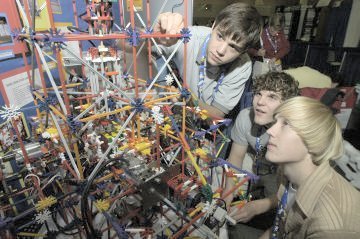 |
|
Intel ISEF finalists (left to right) Patrick D. Loftus, Nathan E. Shepherd, and Zachary Hansen from South Jordan, Utah, examine their Rubik’s Cube robot. |
| Intel |
By dissecting games and sports they love to play, the young researchers found ways to improve their own performance. At the same time, they uncovered some of the science behind their daily activities.
“It’s not just that I’m better at my sport now,” said Kim Sutterer, a 17-year-old volleyball player from Terre Haute, Ind. “It has also helped me understand physics a lot better. When I’m serving, I’m actually thinking about spin.”
Volleyball spin
For her project, Kim used a machine at her high school that automatically serves volleyballs. Depending on the setting, the machine ejects balls with topspin, backspin, or no spin. The launcher can also spit balls out at different angles and different speeds.
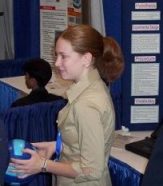 |
|
Kimberly M. Sutterer of Terre Haute, Ind., explains her project on volleyball spin at this year’s Intel ISEF. |
| Courtesy of Kim Sutterer |
Kim studied the paths followed by volleyballs with topspin, backspin, and no spin, launched at three different angles: 0 degrees, 22.5 degrees, and 45 degrees above horizontal. She videotaped three trials of each spin at each angle, for a total of 27 trials. Using a computer program, she plotted each ball’s trajectory on a graph. Finally, she analyzed the data.
A thrown, struck, or kicked ball deflects the air rushing by it, and the air responds by deflecting the ball. When the ball is spinning, the air tends to follow a longer path on one side than on the other because it’s dragged along by the ball’s turning surface. Air following the longer path travels faster and bends more sharply, producing a dramatic drop in air pressure on that side of the ball. The ball is pushed in the direction of the low-pressure side.
An airplane wing experiences a similar effect. As air travels over the upper curved surface of a wing, the pressure drops. The result is “lift,” which makes the object go up.
“When I looked at the data,” Kim says, “I realized how big an effect lift actually has.” The main difference for a volleyball is that the “lift” can be in any direction, depending on which way the ball is spinning.
In general, a spinning ball will curve in the same direction that the front of the ball turns. If the ball has topspin, for example, it will tend to nosedive as it reaches the end of its path through the air.
Physics has given Kim a strategic advantage as an athlete. In games, the junior sometimes puts topspin on the ball to confuse players on the other team. “It will look like it’s coming right at the player,” Kim says, “and then it will drop down before it gets there.”
When players scoot up closer to compensate, she hits the ball so it has backspin or no spin, sending it over their heads.
Kim is still working on her backspin, and she wants to test sidespins next. In the meantime, she says, her whole team is reaping the rewards of her research.
Paintball splatter
William Ryan Roth has been conducting experiments to help his team out, too. Instead of volleyball, though, the 17-year-old junior plays paintball, a sport in which players shoot at each other with splattering balls of paint. If a ball bursts when it hits you, you’re out. If it doesn’t break, you keep on playing. Ryan’s mission has been to invent a padded vest that keeps paintballs from bursting when they hit.
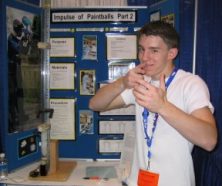 |
|
William Ryan Roth takes aim in front of his project display on paintball impact at the Intel ISEF. |
| E. Sohn |
Ryan plays on a 5-man speedball team. Matches often involve games of Capture the Flag—with a twist. Teams shoot paintballs at each other throughout a game.
Ryan takes his sport seriously. He lives in Taylorville, Ill., but travels as far as Chicago and St. Louis for competitions.
For his science project last year, Ryan found that the thickness of a vest’s padding affects the force of a paintball’s impact. The thicker the padding is, the less force it exerts on the paintball.
This year, Ryan looked at density as well as thickness. He tested a variety of fill materials, including foam, Styrofoam, plastic beads, and fiberfill.
To begin with, Ryan placed a hollow plastic tube vertically over a force probe that measures the impact of a falling object. A special timer recorded how quickly the object dropped. For each trial, he put a sample of material at the bottom of the tube. The density and thickness of the material varied from trial to trial.
“If there isn’t enough material, the paintball will go through, hit your body, and break,” Ryan says. If it’s too dense, the pad will be too hard, and the paint will splatter as well. Similar principles are involved in the design of airbags for cars.
For paintball, there are also practical concerns. The sport requires agility and speed. So, no one would want to wear a thick vest that would be heavy or hot.
In the end, Ryan concluded, the ideal paintball vest would be 11 centimeters thick and be filled with a material that has a density of 0.085 gram per cubic centimeter. He settled on fiberfill.
Ryan is now designing a vest that he can test in the field. At the same time, he’s learned to look at the world with more analytic eyes. You can find physics in things, such as paintball, where you don’t normally expect to, Ryan says.
Scrambled cubes
You also might not expect to find physics in Rubik’s Cube, but that’s exactly what three students from Utah did.
When their physics teacher announced an upcoming science fair, Patrick Loftus, Nathan Shepherd, and Zachary Hansen immediately thought of the Cube. It’s one of their favorite puzzles, and they’re good at unscrambling the puzzle’s small colored cubes by twisting various faces to end up with cubes of the same color on each face.
“We try to go as fast as we can,” says Nathan, 17. “My fastest time is 1 minute, 28 seconds.”
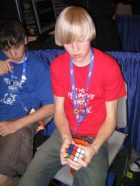 |
|
Zachary Hansen unscrambles a Rubik’s Cube. |
| E. Sohn |
The students decided to build a robot that could solve the cube, too. They used plastic building toys to create the overall structure.
The resulting robot has five arms, one for each of five of the six faces of the cube. Each arm is connected to an air-powered actuator that creates suction and grabs onto the face. Then, a motor turns the face left or right.
To make sure each turn is exactly 90 degrees, the young engineers used a photocell sensor system. In front of the sensor sits a metal disc with four tiny holes placed 90 degrees from each other. When the arm has turned 90 degrees, the sensor picks up light shining through the hole, and rotation stops.
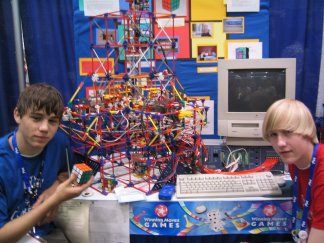 |
|
Patrick Loftus and Zachary Hansen show their robot for unscrambling Rubik’s Cube. |
| E. Sohn |
The robot can’t yet solve Rubik’s Cube on its own. At this point, the boys still have to send commands through a computer that is connected to the robot. “We look at the cube,” says Patrick, 17, “and we tell it what to do step by step.”
Their ultimate goal is to make a robot that can solve Rubik’s cube by itself. Such a robot would need color sensors, moveable grips, and a more advanced computer program.
In the meantime, their robot still has plenty of lessons to offer, the students say. “We feel our project can connect young minds,” Nathan says.
Indeed, the robot was a big hit at ISEF this year, even though safety concerns kept it from performing for the public. While I was talking to Patrick, Nathan, and Zachary, kids kept stopping by to take pictures and ask for autographs.
Science is more than fun, the students found. It can also make you famous.
Going Deeper:
News Detective: Emily Goes to a Science Fair







